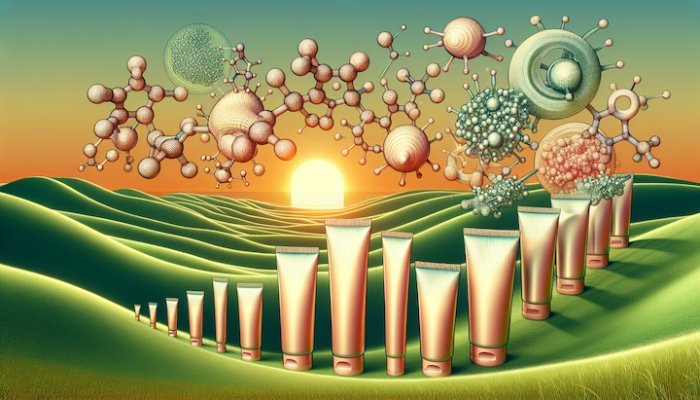Effects of progesterone
The known beneficial effects of progesterone make for a very long list. The term progesterone is often used as a generic one for the different types of both natural and synthetic 'progestins' or 'progestagens'. This is not appropriate, as natural progesterone has properties very distinct from the synthetic progestins.
Within the nervous system, the neuroprotective and promyelinating effects of progesterone are promising not only for preventing, but also for reversing, age-dependent changes and dysfunctions. There is indeed strong evidence that the aging nervous system remains at least to some extent sensitive to these beneficial effects of progesterone.
Estrogen stimulates cells to grow, which can lead to cancer. Progesterone inhibits the action of estrogen, hence it is protective against cancer.
Progesterone also activates the gene p53, which if inactive or mutated prevents cells from dying naturally.
One of the most important effects of progesterone is as a potent diuretic. As such it prevents the aldosterone increase in sodium, thereby reducing water retention. It is now being given via IV transfusion to brain trauma victims because of this.
It is a known stimulant of IL-10, which is an anti-inflammatory agent.
Progesterone also stimulates the release of Th2 cytokines, which are anti-inflammatory and directly inhibits Th1 cytokines which are pro-inflammatory.
It has been shown to reduce the response of natural killer (NK) cells as well as other known initiators of inflammation.
Matrix metalloproteinases (MMP) play a role in inflammation. Estrogen maintains secretion of matrix metalloproteinases. In contrast, one of the effects of progesterone is as a natural inhibitor of metalloproteinases. Matrix metalloproteinases are implicated in cancer and arthritis.
Progesterone prevents lipid peroxidation and confers vascular protection. It has an antiatherogenic action by preventing the conversion of cholesterol into cholesteryl ester. It prevents vasoconstriction by increasing levels of nitric oxide (NO), which causes vasodilation allowing blood vessels to relax, and so widens them allowing more blood to flow through and it inhibits platelet aggregation.
It is a natural inhibitor of 5-alpha reductase, so can prevent the conversion of testosterone to di-hydrotestosterone (DHT), implicated in prostate cancer.
Progesterone helps with both depression and insomnia as it raises serotonin levels in the brain. Serotonin is our 'happy' neurotransmitter, it is also the precursor to melatonin (the 'sleep' hormone).
One of the little known effects of progesterone is that it has a calming effect by activating the GABA receptor sites. GABA is our most calming, inhibitory neurotransmitter and effective against some forms of epilepsy.
Progesterone boosts the immune system. It is also neuroprotective and helps stabilize blood sugar.
Progesterone plays a major role in the body...
- It is not a female hormone.
- It is not a sex hormone,it plays no part in the secondary sexual characteristics which develop at puberty.
- It is secreted primarily by the ovaries in women and the testes in men.
- Smaller amounts are produced by the adrenal glands, the brain and glial cells (non-neuronal cells that provide support and nutrition).
- There are no quantitative differences between men and women (at least outside the luteal phase).
Special section on traumatic brain injury
An Emory University researcher has developed what could be the first drug therapy to treat traumatic brain injury - a condition that affects more people than breast cancer, prostate cancer and HIV combined.
Research papers...
Emory University News Release: Jan. 14, 2010
Atlanta To Serve as National Epicenter for Promising Phase III Brain Injury Treatment Trial
Emory University News Release: Nov. 2, 2009
Sound Science Podcast: Progesterone - It's More Than a Sex Hormone
Emory University News Release: Research, School of Medicine Jun. 23, 2009
Emory Announces Phase III Study of Progesterone for Traumatic Brain Injury
Here is a more or less comprehensive listing of the effects of progesterone...
- the precursor to the sex hormones estrogen and testosterone
- is essential for implantation and pregnancy maintenance
- prevents lipid peroxidation
- acutely inhibits cholesteryl ester formation which is associated with atherosclerosis
- confers coronary vascular protection
- protects against breast, ovarian and endometrial cancer
- increases relaxation in human placental arteries and veins
- increases intelligence in utero
- inhibits the mitogenic action of estrogen on the endometrium and enhances differentiation
- has an inhibitory effect and reduces epileptiform activity in the brain
- has immunosuppressive properties
- simulates leptin secretion
- sleep improvement
- influences spermiogenesis, sperm capacitation/acrosome reaction and testosterone biosynthesis in the Leydig cells in men
- significant reductions in menopausal symptoms
- significant improvement in vasomotor symptoms
- acts indirectly to increase aldosterone by mechanisms similar to sodium restriction
- is effective in reducing the risk of spontaneous abortions in high-risk patients
- prevents recurrent miscarriage and reduces implantation failure in assisted reproduction cycles
- reduces the frequency of uterine contractions and the rate of preterm delivery in women at high risk for prematurity
- inhibits in-vitro embryotoxic Th1 cytokine production to trophoblast in women with recurrent pregnancy loss
- promotes regeneration and myelination of axons
- has a neuroprotective and antioxidant effect in injured nervous system
- has multiple effects on glial cells
- it influences growth, differentiation and increases the expression of myelin-specific proteins in oligodendrocytes, and potentiates the formation of new myelin sheaths by Schwann cells in vivo
- the loss of progesterone may contribute to the deficits observed after ovariectomy or the increased risk for Alzheimer's disease seen after the menopause
- the metabolite allopreganolone potentiates the action of GABA
- it appears to act directly on bone by engaging an osteoblast receptor or indirectly through competition for a glucocorticoid osteoblast receptor
- it increases cell number in human osteoblastic cells
- induces the increase of the parasiticide activity of the leukocytes involved in the mechanisms of Trichinella spiralis newborn larvae death
- significantly lower levels of progesterone are found in women with PCO in the early luteal phase which may contribute to the delay in conception in these patients
- the abnormal capacity to synthesize progesterone in PCOS may explain the anovulation and miscarriage that occurs in these patients
- lower levels of the anxiolytic progesterone metabolite allopregnanolone are found in the luteal phase of women with PMS
- serum allopregnanolone levels are significantly lower in women experiencing postpartum "blues"
- it is shown to be efficacious when continuation of pregnancy is hampered by immunological factors, luteinic and neuroendocrine deficiencies and myometrial hypercontractility, this may explain the reduction in the incidence of preterm birth in high-risk pregnant women using high-dosage prophylactic progesterone
- it reduces the frequency of uterine contractions and the rate of preterm delivery in women at high risk for prematurity
- evidence suggests that HLA-G plays a critical role in maternal immune tolerance to the fetus, it was found that progesterone has an up-regulatory effect on HLA-G gene expression in first trimester trophoblasts
- conservative treatment with high-dose progesterone for endometrial hyperplasia and well-differentiated early-stage adenocarcinoma followed by assisted reproductive technologies is an appropriate means for achieving pregnancy
- in assisted reproduction, luteal support is mandatory and progesterone is the most widely used hormone, it can be delivered orally, intramuscularly and vaginally. The oral route is the least efficient but the intramuscular route is as efficient as the vaginal route; however, the latter is more acceptable, especially during prolonged treatments, such as oocyte donation and frozen embryo transfer cycles, is used effectively to prevent threatened abortion in the first trimester
- higher serum concentrations of progesterone but not oestradiol, in early pregnancy were related to lower mean systolic blood pressures in the second and third trimesters
- a progesterone/testosterone cream was able to help correct the hormonal imbalance commonly found in men with erectile dysfunction
- used in the treatment of benign prostate hyperplasia (BPH) in men via a transscrotal delivery system
- used to lower dihydrotestosterone levels in men, the progesterone metabolite 17-0H-progesterone was found to have the highest inhibitory effect on 5-alpha reductase
- low allopregnanolone levels in premenopausal women with PTSD (post traumatic stress disorder) might contribute to an imbalance in inhibitory versus excitatory neurotransmission, resulting in increased PTSD re-experiencing and depressive symptoms
- it demonstrates a significant increase of the elastic skin properties, a greater reduction in wrinkle counts and wrinkle depth around the right eye, a greater decrease in nasolabial wrinkle depth and a significantly higher increase in skin firmness in peri- and postmenopausal women
- topically applied progesterone is rapidly absorbed transdermally and its patterns of distribution and metabolism are comparable to those previously reported for intravascularly administered progesterone
- the progesterone metabolite allopregnanolone reduces the brain's response to stress
- progesterone regulates the secretion of catecholamines during stress, modifies positively the cardiovascular and catecholamine response to mental stress in menopausal women
- it reduces programmed cell death and the synthesis of inflammatory factors that can kill neurons hours to days after traumatic brain injury
- as an anti-inflammatory agent progesterone has been shown to reduce the response of natural killer cells as well as other known initiators of inflammation
- systemic injections of the neurosteroid progesterone given after traumatic brain injury (TBI) have been shown to improve cognitive, sensory and motor recovery, enhancing both short and long term recovery
- readily crosses the blood brain barrier (BBB) reducing oedema to barely measurable levels
- reduces lipid peroxidation and the generation of isoprostanes, which contribute to post-injury ischaemic conditions
- produces metabolites which decrease pro-apoptotic and increase anti-apoptotic enzymes
- reduces the expression of pro-inflammatory genes and their protein products
- reduces the area of necrotic cell death and improve behavioural outcomes
- protects neurons distal to the site of injury which would normally die after TBI
- enhances remyelination in degenerative disorders
- produces significant sparing of cognitive, sensory and spatial learning performance after bilateral brain injury
- TBI yielded extremely promising results and found no adverse events attributable to progesterone
- unlike estrogen which can exacerbate brain injury, especially in animal models of ischaemic stroke, progesterone can be given to both males and females without affecting gender and sexual functions
- progesterone, unlike the synthetic progesterone medroxyprogesterone acetate (MPA), cannot increase infectibility to sexually transmitted diseases. MPA also increases susceptibility to genital herpes (HSV-2) ten times more than does natural progesterone
- progesterone brings about relaxation of smooth muscle in the urinary system
There are many research papers on the effects of progesterone showing the protective role it plays in the body...
 Finding natural solutions to hormonal problems is a quest for many women worldwide. Organic progesterone creams emerge as a favoured choice offering a natural balance without the complications attache…
Finding natural solutions to hormonal problems is a quest for many women worldwide. Organic progesterone creams emerge as a favoured choice offering a natural balance without the complications attache… Navigating perimenopause, a period when progesterone becomes crucial for a woman’s well-being, can be quite challenging as one grapples with an array of symptoms. From the age of around 35, the produc…
Navigating perimenopause, a period when progesterone becomes crucial for a woman’s well-being, can be quite challenging as one grapples with an array of symptoms. From the age of around 35, the produc…